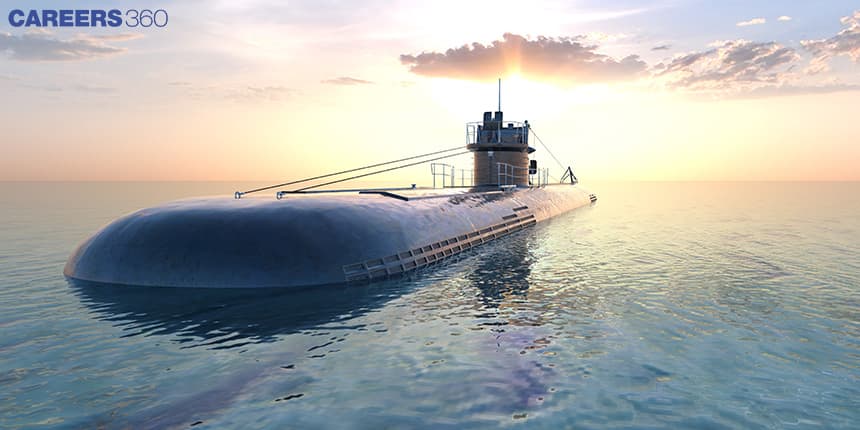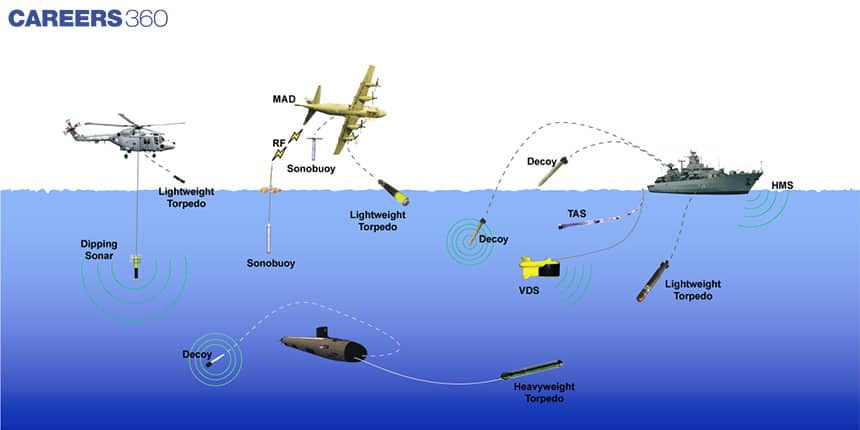How Can Probability And Statistics Help In Tracking Submarines?
Submarines are designed to operate covertly and avoid detection, making them difficult to track and locate. Their stealth technology, ability to travel great depths, and countermeasures all contribute to the difficulty in tracking them. Additionally, the vast and dynamic ocean environment, as well as the limitations of advancement in detection technology, complicate the task further.

In this context, tracking a submarine requires advanced technology, sophisticated detection methods, and skilled personnel. Despite the challenges, tracking submarines is a critical task for national security and requires ongoing efforts to develop new technologies and techniques. However, with the help of probability and statistics, it is possible to track these submarines. How we do it is taught in Class 12, through fundamental concepts of probability and statistics.
Concepts That Help In Tracking Submarines
From Class 12 Maths, the concept of Probability and Statistics that can be applied to tracking the movement of submarines. Some of these concepts are:
Probability: Probability is the study of how likely an event is to occur. In the context of tracking submarines, probability can be used to determine the likelihood of a submarine being in a particular location at a particular time. Probability can also be used to calculate the probability of different scenarios, such as the probability that a submarine will change course or speed.
Random variables: A random variable is a variable that takes on different values with certain probabilities. In the context of tracking submarines, random variables can be used to model the uncertainty associated with the submarine's position, speed, and direction of travel.
Distribution functions: Distribution functions describe how the probabilities are distributed among the different possible outcomes of a random variable. In the context of tracking submarines, distribution functions can be used to model the probabilities of different scenarios, such as the probability of the submarine being in a certain location at a certain time.
Bayes' theorem: Bayes' theorem is a mathematical formula that allows us to update our beliefs about a particular event based on new information. In the context of tracking submarines, Bayes' theorem can be used to update our beliefs about the submarine's location, speed, and direction of travel based on new sensor data or other information.
Hypothesis testing: Hypothesis testing is a statistical technique used to test whether a particular hypothesis is true or false. In the context of tracking submarines, hypothesis testing can be used to test whether the submarine is following a particular course or whether it has changed course.
Also Read | Truss Bridges: A Structural Marvel Made Possible By Triangles
Tracking Submarines Is A Difficult Task

Tracking a submarine is a difficult task for several reasons:
Stealth Technology: Submarines are designed to be stealthy, which means they are built to avoid detection. They have a low acoustic signature, which makes them difficult to detect using sonar or other detection methods.
Depth and Distance: Submarines can travel at great depths, which makes them hard to track. They can also move quickly and cover large distances in a short period of time, making them difficult to locate.
Ocean Environment: The ocean is a vast and dynamic environment, with many factors that can interfere with tracking efforts. For example, water currents and temperature gradients can distort sonar signals, and the presence of marine life can also create false readings.
Limited Detection Equipment: The technology used to detect submarines, such as sonar and satellite imaging, has limitations in terms of range and accuracy. This means that it can be difficult to detect a submarine until it is in close proximity.
Countermeasures: Submarines are equipped with countermeasures, such as decoys and electronic jamming devices, which can further complicate tracking efforts.
Now let's understand the several methods of tracking the submarines
Also Read | Explore The Science Of Wheelies: How Physics Makes This Motorcycle Manoeuvre Possible
Methods Of Tracking The Submarines
There are several methods including passive and active sonar systems that are used to track submarines.

Passive Sonar System
It uses sound waves to detect and locate submarines underwater. The sound waves are sent out into the water, and when they hit the submarine, they bounce back to the sonar receiver. By analysing the patterns of these sound waves, it is possible to determine the location and direction of the submarine.
Active Sonar System
This system works by sending out sound waves, just like the passive sonar system. However, in this case, the sound waves are actively directed toward the submarine. The waves bounce off the submarine and return to the sonar receiver, providing information about the location and direction of the submarine. The active sonar system is more accurate than the passive sonar system.
The Kalman Filter
One mathematical model that can be used to track a submarine with statistics and probability is the Kalman filter. The Kalman filter is a recursive algorithm that uses a series of measurements over time to estimate the state of a system.
To track a submarine using a Kalman filter, you would first need to define the state variables that describe the position and velocity of the submarine. You may choose to represent the state as a 6-dimensional vector, consisting of the three position coordinates and three velocity coordinates.
Next, you will need to define a measurement model that relates the state variables to the measurements we can make with our tracking sensors. For example, if we are using sonar to track the submarine, our measurement model might relate the state variables to the time delay between the transmission of a sonar ping and the detection of the echo.
Once you have your state variables and measurement model, we can use the Kalman filter to recursively estimate the current state of the submarine based on your previous estimates and new measurements. The Kalman filter uses statistics and probability to update our estimate of the state based on the accuracy of our measurements and the uncertainty in your model.
The detection and tracking of submarines using probability and statistics are not foolproof. There is always a margin of error in the data collected, which can lead to inaccurate predictions. Additionally, submarines are equipped with countermeasures such as noise reduction technology, which makes them even more difficult to detect and track.
Applications for Admissions are open.
As per latest syllabus. Physics formulas, equations, & laws of class 11 & 12th chapters
JEE Main Important Chemistry formulas
Get nowAs per latest syllabus. Chemistry formulas, equations, & laws of class 11 & 12th chapters
JEE Main high scoring chapters and topics
Get nowAs per latest 2024 syllabus. Study 40% syllabus and score upto 100% marks in JEE
JEE Main Important Mathematics Formulas
Get nowAs per latest syllabus. Maths formulas, equations, & theorems of class 11 & 12th chapters
